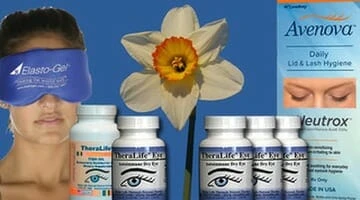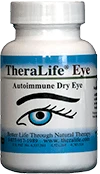Powerful Sjogren’s Relief That Works

All Natural Oral Sjogren’s Starter Kit
- Oral relief for dry eyes. No more drops
- Restore and revive your own tears from inside out.
- Reduce autoimmune flares
- Reduce joint pain
- 100% money back guaranteed.
Testimonial
"I have been taking this product [TheraLife-Eye] for a week. I had LASIK 6 weeks ago, and I have noticed a big improvement. I no longer wake up with dry eyes. My eyes do not feel sore or gritty during the day. I consider the money I paid well spent." –T.T., McAllen, TX
*Results may vary
Call and talk to a doctor if TheraLife is right for you- 1-877-917-1989 US/Canada
Early diagnosis and effective treatments are vital for people with Sjogren’s Syndrome. Proper treatments may improve symptoms, prevent recurring flare-ups, and avoid future complications.
 Why TheraLife® Eye Autoimmune?
Why TheraLife® Eye Autoimmune?
Eye drops treat from the eye surface. TheraLife therapy is oral relief from the inside out.
All Natural, Suitable for Vegans
Immune Modulation
TheraLife® has developed an oral formula that regulates autoimmune disease through “immune-modulation.” Immune modulation refers to medical intervention to alter the body’s immune response when not performing correctly. TheraLife® Eye Autoimmune reduces Inflammation and relieves clinical symptoms.
Why TheraLife Protocol?
TheraLife Eye Autoimmune capsules relieve dry eye syndrome, especially Sjogren’s. TheraLife’s Autoimmune Protocol covers dry eyes and blepharitis, MGD, and Inflammation. TheraLife succeeds where eye drops fail.
Sjögren’s syndrome and Dry Eye
Dry eye is considered an ocular surface disease.
A specialty doctor evaluates dry eye conditions to prescribe the proper treatment.
Many aspects of dry eye syndrome.
- Tear evaporation – Very fast tear film breakup time.
- Insufficient tear production – confirmed by Schirmer’s test.
- Abnormal Eyelid and eyelash structure- causing recurring chronic blepharitis, ocular rosacea.
- Clogged meibomian oil glands – MGD. Prescribe warm compresses daily.
- All the typical dry eye symptoms
- Sjogren’s Blepharitis – Eyelid inflammation, infection, and swelling.
- An overactive immune system may require immunosuppressive drugs.
Definition
Sjogren’s is an autoimmune disease where the body’s immune system turns against itself and attaches to mucous membranes and moisture. Including eyes, mouth, lungs, and vaginal areas.
Symptoms
Sjogren’s syndrome begin in adults in their 40’s. These may include:
- Dry eye – including infection of the eyelids, clogged oil glands, blurred vision, abnormal tear film, cornea abrasion, burning sensation to the eyes
- Blepharitis – eye infections affect eyelashes.
- Eyelashes turning inward or outward
- Dry mouth – swollen salivary glands
- Dry skin and rashes
- Fatigue
- Joint and muscle pain
- Nerves-Numbness or tingling in the hands or feet.
- Vaginal dryness
Conditions That Might Indicate A Serious Problem
In some cases, Sjogren’s can lead to potentially serious complications, such as pneumonia, vasculitis, pancreatitis, and a higher risk of developing lymphoma. Seek prompt medical care if you have any of these :
- Decreased urination
- Eye pain or eyesores
- High fever (higher than 101 degrees Fahrenheit)
- Severe abdominal pain
- Swollen lymph nodes
- Wet, loose cough that produces yellow, green, or white phlegm
- Yellowing of the skin and whites of the eyes (jaundice)
Diagnosis
Early diagnosis and treatment are essential for preventing disease complications. However, this can be difficult and has taken an average of 7 years from the onset of the disease.
Dryness in the mouth and eyes can also occur for other reasons, such as a side effect of medications (including antidepressants and blood pressure medication), making diagnosis very difficult.
However, dryness in the eyes and mouth, plus cavities, are good signs to start investigating for Sjogren’s syndrome.
Other Factors That Make Diagnosis Difficult
- Drugs and Medications – Sometimes, the use of certain medicines can cause side effects that mimic Sjogren’s. Medications such as tricyclic antidepressants, antihistamines like Benadryl.
- Extraglandular Features – Numerous extra glandular features may develop, such as arthralgia, arthritis, Raynaud phenomenon, myalgia, pulmonary disease, gastrointestinal disease, leukopenia, anemia, lymphadenopathy, neuropathy, vasculitis, renal tubular acidosis, and lymphoma.
- Skin -50% of patients with Sjogren’s syndrome have dry skin (xeroderma), palpable and nonpalpable purpura, or urticaria.
- Overlapping Clinical Symptoms – Primary Sjogren’s syndrome occurs in the absence of another underlying rheumatic disorder. In contrast, secondary Sjogren syndrome has another underlying rheumatic disease, such as systemic lupus erythematosus, rheumatoid arthritis, or scleroderma.
- Viral Infections – Viral infections can look similar to Sjogren’s syndrome. These infections include viral infections such as hepatitis C, human immunodeficiency virus (HIV), and human T-cell lymphotropic virus (HTLV).
Traditional treatment
Diseases are diagnosed and treated to control disease conditions before they affect other organs.
Dry Mouth Saliva substitutes, Saliva stimulants, Interferon-alpha,
Dry Eyes – Artificial tears, eye ointments, autologous serum drops- (treatment from the eye surface), hot compresses (to open up clogged oil glands)
Blepharitis – antibiotics, warm compresses, and eyelid cleanser.
Immunomodulatory drugs
Punctal plugs or surgery
Vaginal Dryness – Use lubricants explicitly made to help vaginal dryness.
Psychological and Emotional – Join a regional support group, try meditation and yoga.
Complications
Lymphoma
People with this disease have a higher non-Hodgkin lymphoma rate than people with other autoimmune diseases and healthy people.
Other complications – read more here
Diet for Sjogren’s – learn more
References


Sjogren's Syndrome


